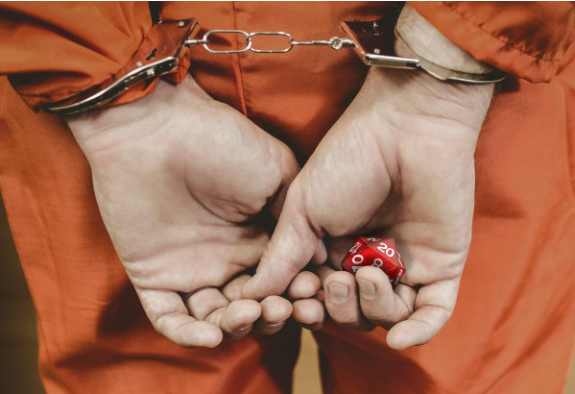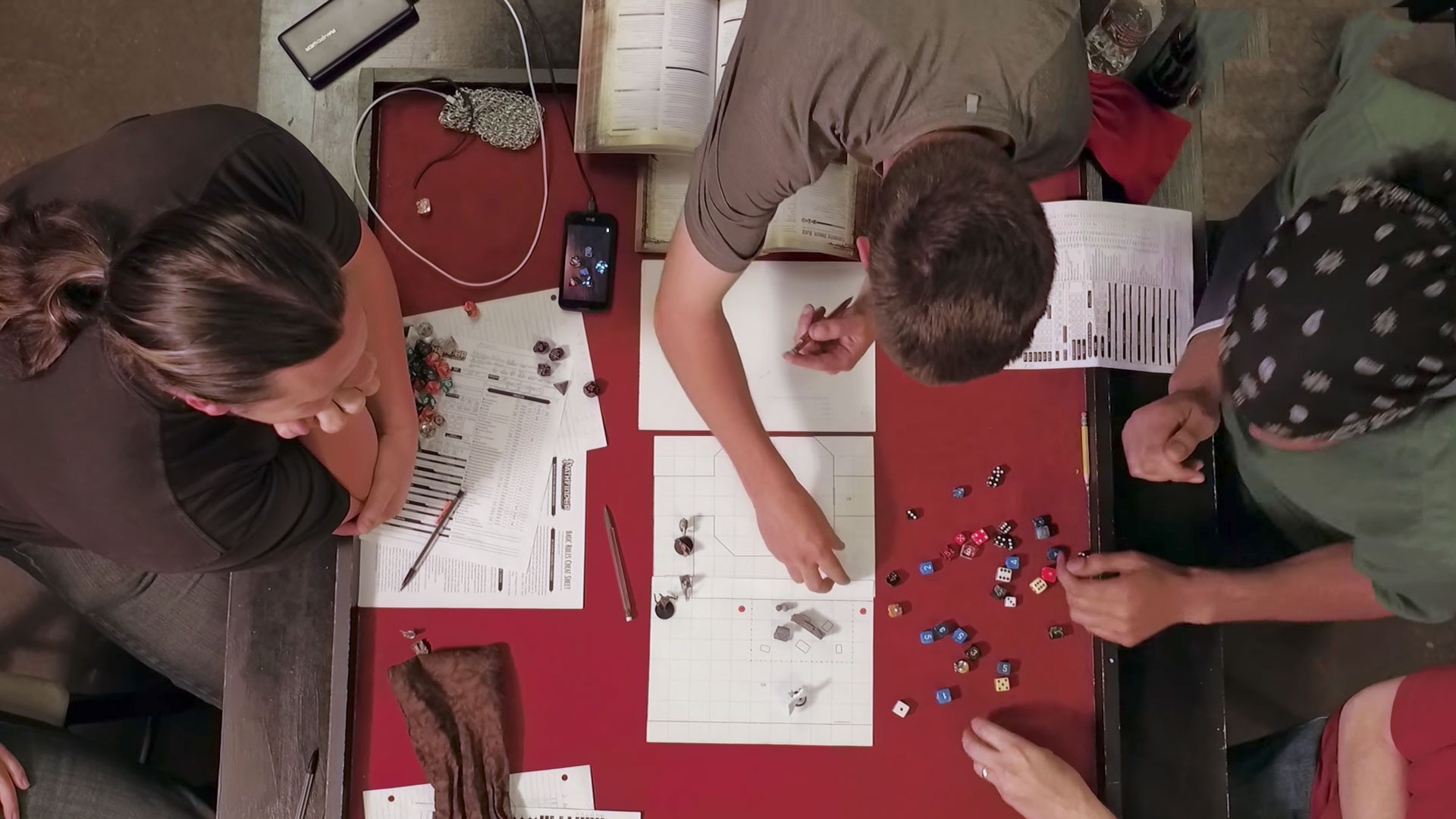At Play in the Carceral State is a week-long series investigating play in, around, and about prisons and prison culture. Learn more here.Original published on October 27, 2016Sterling Correctional Facility is not the kind of place where people are known to play nice. A maximum security prison 130 miles northeast of Denver, it houses some of Colorado's most egregious offenders: murderers, bank robbers, even a few serial killers—rule-breakers of all kinds. Yet, every afternoon, half a dozen inmates gather around a table in the common room to join forces against imaginary foes in a cooperative game of Dungeons and Dragons (1974).
Advertisement
D&D, a role-playing game created by Gary Gygax and Dave Arneson, as been played by over 20 million people since it was first published in 1974. Per the game's rules, the inmates choose imaginary characters and roll dice to determine their strengths and skills. As a party, they work their way through fantasy worlds—solving puzzles, vanquishing enemies, and acquiring treasure.The course of the game is guided by a dungeon master (known as a DM) who has spent hours preparing for the session, using his imagination to create worlds and storylines and to develop quests for his players. Some DMs use books with pre-fabricated stories and plots; others—including the inmates at Sterling—prefer to do a lot of this creative heavy-lifting themselves. Dice, including the D20—a 20-sided die that's the hallmark of a gaming session—aren't allowed behind bars, so the inmates have gotten resourceful and instead use a set of 20 playing cards to make "rolls."

Over the course of the three hour sessions, the players, who represent many different races and in some cases gang affiliations, set aside their differences and assume the virtual skins of their characters: elves, dwarves, halflings, etc. As the dungeon master leads them on quests to kill mythical monsters, concrete and iron bars give way to a haunted forest, a dragon's lair, or a castle's keep—dungeons of another kind.A 6'6", 33-year-old Melvin Woolley-Bey cuts an imposing figure at Sterling. Since the age of 18, he's been charged over a dozen times for thefts, burglaries, and drug possessions. For all intents and purposes, the Department of Corrections (DOC) is home.When Bey was a boy, he wanted to be a playwright. "Live theatre has always held my imagination," he says, "To depict the passage of time and the growth of individuals within the confines of not just linear time, but the stage itself is… intense. It offers a challenge that I think pushes writers to their limits." However, during his teens, his home life collapsed, and he found himself on the streets where he fell into drugs.
Not Your Typical Gamer
Advertisement
When Bey first stepped foot in Sterling, he noticed a group of inmates playing D&D. Bey had been drawn to the game in his teens because of its similarities to theater, but it had been years since he played. He joined the game and quickly found in it a welcome opportunity to shed the hardened persona that helped him survive on the streets.

For the last couple years, Bey has been playing in a group led by dungeon master Aaron Klug—a reclusive inmate with an affinity for numbers and systems, but who struggles to connect with other people. When it comes to commitment to D&D, no one can beat Klug, who lives and breathes gaming. When he's not running the game, he's in his cell drafting character sheets and drawing maps. "I've been playing games since I can remember," Klug says. "It's the one thing that few can beat me at. In the system or on the streets, it's what I do."Like Bey, Klug's been in and out of institutions since his teens. He is currently serving an eight-year sentence for robbing a bank back in 2010. Police knew Klug was their suspect, but didn't know how to find him. After three months of detective work, they ran an online search and noticed he'd registered for a local D&D event. The event posting read, "Adventure awaits as you journey to the Nentir Vale and face down savage beasts and lurking evils at the edge of civilization." They showed up to the event and arrested him on the spot. The next day, it was in the headlines: "Fantasy Game Player Arrested in Real Life Robbery." Naturally, the first thing Klug did in prison was start up a game.
Advertisement
Currently, Bey plays a female halfling (he offers in a high-pitched tone—clearly his role-playing voice). Role-playing a female character in prison seems like it would take guts, but Bey isn't worried. "When you're in a setting like prison," he says, "where so much depends on bravado and presenting a credible threat, to sit down and play a game that has the word 'faerie' anywhere in it takes a certain self-confidence that I think demands respect."Then again, Bey may be downplaying what it took to earn that respect in the first place. A couple years ago another inmate who was not a member of the group had gotten into the habit of interrupting their game to taunt the players. With each interruption, Bey became increasingly irate until one day, he couldn't take it anymore. "I told you to quit messing with us while we're playing our game," he screamed as he jabbed his pencil into the bully's thigh multiple times. Bey's justification: "In the facility, we have three hours a day of pod time where we have access to the tables and we're not locked down. So we have very little time to game and this time has to be shared with phone calls, showers, etc. The last thing we need is a level six npc distracting the players." Prison officials sent Bey to solitary confinement, where he convinced the inmates in neighboring cells to play a game with him by yelling through the ventilation shafts.So, how do correctional officers view role-playing games like Dungeons and Dragons?According to Klug, most of the guards at Sterling tolerate the game, even looking on with bemused curiosity and asking questions. Perhaps they are struck by the unexpected juxtaposition of some of their most notorious troublemakers slipping into the skins of elves and other fantasy creatures. Some even go so far as to encourage it: "They like that it takes a lot of imagination. I've even had correctional officers go to the office and print up dungeons, new rules and all kinds of stuff for our game," Bey says.
Bey's justification: "In the facility, we have three hours a day of pod time where we have access to the tables and we're not locked down. So we have very little time to game and this time has to be shared with phone calls, showers, etc. The last thing we need is a level six npc distracting the players." Prison officials sent Bey to solitary confinement, where he convinced the inmates in neighboring cells to play a game with him by yelling through the ventilation shafts.So, how do correctional officers view role-playing games like Dungeons and Dragons?According to Klug, most of the guards at Sterling tolerate the game, even looking on with bemused curiosity and asking questions. Perhaps they are struck by the unexpected juxtaposition of some of their most notorious troublemakers slipping into the skins of elves and other fantasy creatures. Some even go so far as to encourage it: "They like that it takes a lot of imagination. I've even had correctional officers go to the office and print up dungeons, new rules and all kinds of stuff for our game," Bey says.

Dungeons Masters and Prison Bosses
Advertisement
However, over the years, there has been the occasional guard who read sinister motives into the game. A couple years ago, Bey says, "a lieutenant took an active interest in breaking up our game, taking our pieces and sending out maps to the board to make sure they weren't escape plans.
Original art by Paul O'Reilly
As it turns out, that wasn't the first time correctional officers have suggested D&D could pose a security threat. Back in 2004, at Waupun Correctional Institution in Wisconsin, inmates were banned from playing D&D, and Dungeon Master, Kevin T. Singer's, gaming materials were confiscated, including a 96-page handwritten manuscript outlining a campaign he was developing for the game.Singer sued the prison, claiming the seizure and ban violated his free speech and due process rights.At the trial, Captain Bruce C. Muraski, the prison's security supervisor and also the man responsible for the confiscation, attempted to justify the prison's decision. He testified that role-playing games like D&D "promote competitive hostility, violence, and addictive escape behavior, which can compromise not only the inmate's rehabilitation and effects of positive programming, but endanger the public and jeopardize the safety and security of the institution." Singer appealed the decision and six years later, it escalated to the United States Court of Appeals, Seventh Circuit. There, Singer presented testimony to show that D&D—and roleplaying games in general—were effective tools for rehabilitating inmates, yet the appeals court upheld the ban.
Advertisement
While inmates have access to many games in prison, D&D is one of the few that is actually cooperative by rewarding players who work together. What's more, evidence suggests that games like D&D foster—not competitive hostility as suggested in the trial—but positive social behavior that could serve them in the outside world.In 2012, a research group at the University of Ohio set out to study how playing videogames cooperatively or competitively impacted subsequent cooperative behavior. Groups of participants were tasked with playing the first-person shooter Halo 2 (2004) in either a competitive player vs. player mode or a cooperative mode where they teamed up with the other player and had to work together to beat a computer-generated opponent. After each game, the participants were given a dilemma. They were given four dimes that they could either keep or give to the other player. If they gave the dimes to the other player, the dimes would double in value for that other player. In game theory, this type of situation is sometimes referred to by economists as the Prisoner's Dilemma. The researchers found that when playing in cooperative mode, the participants were significantly more likely to give away the dimes and both players walked away with more money. When playing competitively, they were more likely to keep the dimes for themselves.Klug has been playing D&D his entire life—in and out of prison. When I first spoke with him, I asked what challenges he initially faced as a DM that were specific to playing behind bars. He said that no matter how unified his players tried to be, initially "Our parties couldn't get along to save their character's lives." They lacked teamwork and played competitively even when faced with a shared goal. What's more, they would repeatedly make decisions to maximize their own profit, even at the risk of undermining the mission and hastening the group's demise. Yet after years of playing, Klug says his gaming group has gotten a lot better at working together as a team. Bey agrees: "Above all, without fail, any gang ties, religious obligations or racial affiliations are superseded by the game." Around the gaming table, nobody is black or white or Latino; they are elves, dwarves, and halflings. The game is about bringing people together in a way that overcomes differences. "I believe in a world where a 90 pound geek can become a sword-wielding barbarian or a science dunce can learn to manipulate an alchemist class… and then bring these two together in a common interest."
Advertisement
Research suggests that role-playing games like D&D can be powerful therapeutic tools. Back in 1994, a psychologist named Wayne D. Blackmon published a case study showing how D&D was used to help rehabilitate a suicidal 19-year-old who was not receptive to talk therapy. Through fantasy role-playing, the patient was able to access and express threatening fears and emotions in a structured, safe environment. Blackmon has since championed the use of D&D to help patients "to explore their mental dungeons and slay their psychic dragons."For Klug, the D&D table is the only safe space available in prison to be introspective. Despite being in the system for most of his life, Klug is not designed for life behind bars where recreation (both official and unofficial) is centered around physical activity and socializing—two things Klug struggles with. "Rehabilitation in the DOC is structured in a way that gives no alternatives. Not everybody is built the same. I don't care about construction classes or dealing with people." The D&D table may be the one place Klug can look inward and engage in the kind of problem-solving where analytic introverts shine. As Klug puts it, " Dungeons and Dragons is my rehabilitation that I can deal with to escape into my own reality to solve my own problems."So what if role-playing games can be proven to be rehabilitative? Does that mean inmates should be entitled to play? Ultimately, that was the question at the fulcrum of the Singer trial.Correctional institutions in America have suffered from a conflicted sense of self-identity. On the one hand, they're meant to be rehabilitative, with the stated aim to provide inmates with tools and coping mechanisms to help reduce the chance of recidivism. On the other, they're punitive—designed to punish the nation's most appalling rule-breakers by confining them to a place of limited stimulation where they are forced to look inward and confront their own decisions day after day. In the Singer trial, the court ruled that, "punishment is a fundamental aspect of imprisonment, and prisons may choose to punish inmates by preventing them from participating in some of their favorite recreations." If fantasy escapism becomes too fun… if it becomes itself a distraction from the suffering one has caused… then is it really something that belongs in prison?Perhaps we need to reframe the way we think of escapism.A psychologist named Frode Stenseng at the University of Oslo differentiates between two types of escapism: "self-suppression escapism" and "self-expansion escapism." The former is an avoidance tactic while the latter actively seeks new skills and strengthens character.Which kind of escapism the inmates at Sterling gravitate to is perhaps best illustrated by the moral alignment they choose for their characters. In D&D, a character's moral compass is known as their 'alignment' and is determined by two axes: good/evil and lawful/chaotic. On one extreme are the lawful good characters, defined by their sense of compassion and affinity for the rules. On the other, chaotic evil—callous rule-breakers driven by self-interest. Despite their often erratic real life behavior, Klug noted that his players gravitate towards lawful good characters. Sometimes, this role involves self-sacrifice—a trait not usually associated with prison life. Yet these inmates are game to try. After all, everyone likes to think of him or herself as a good person, and the best way to get there could be through a little practice and a daily dose of game therapy.Have thoughts? Swing by Waypoints forums to share them!